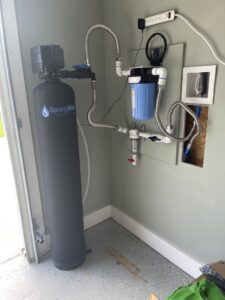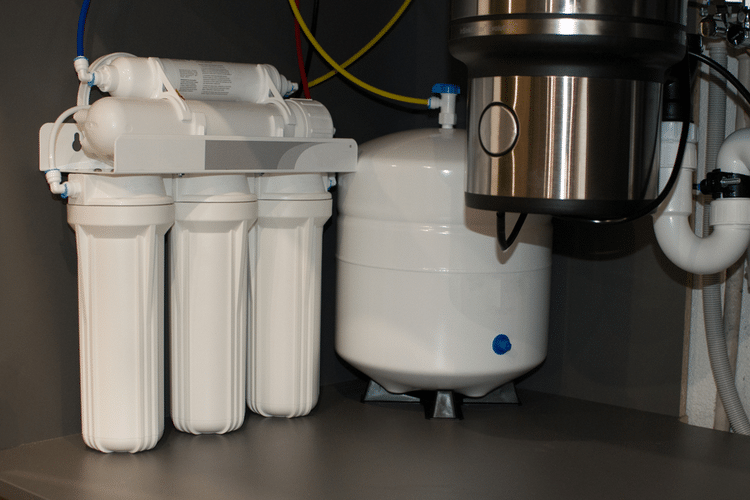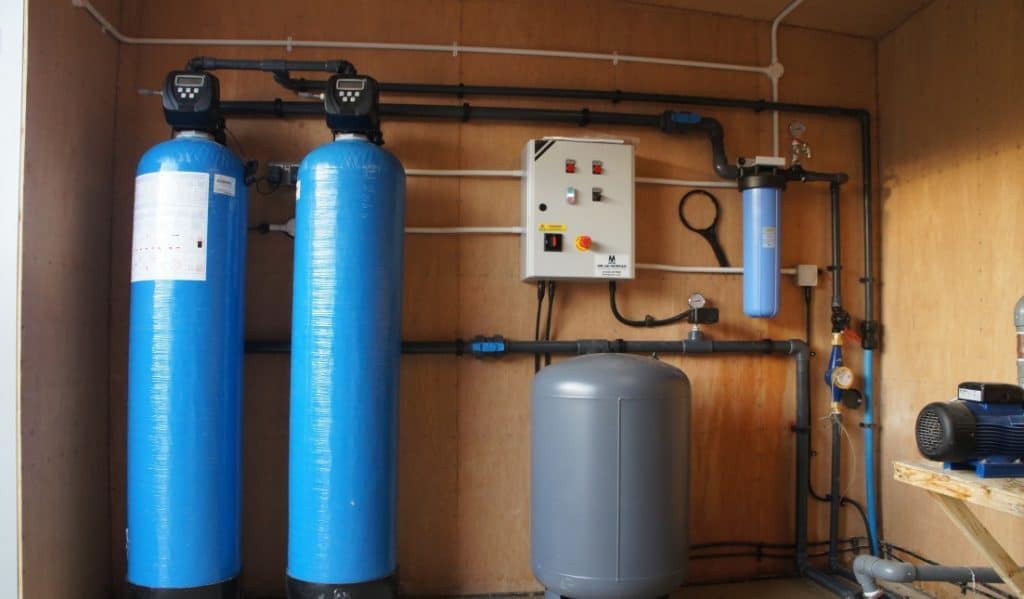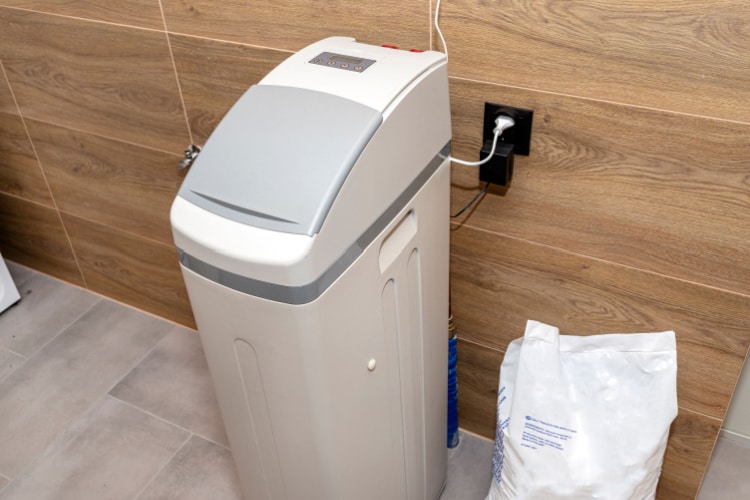It’s very common to find iron in well water. Rocks and soil contain minerals, most notably iron. Rainwater causes these minerals to seep deeper and deeper into the soil until they eventually reach the aquifers from where wells draw their water.
While you can’t prevent iron from building up in the well, there are several methods that you can use to remove the collected iron minerals from your water supply.
You can use a water softener to get rid of ferrous iron, a manganese water filter to get rid of ferric iron, shock chlorination to get rid of organic iron, or you can simply go for the cheapest option and get a reverse osmosis system.

- Fe Types Removed: Ferrous, Ferric
- Max Iron Level: Up to 7 PPM
- Process: Air Injection + Greensand
- Flow Rate: 11 – 20 GPM
Do You Need to Remove the Iron?
Having a bit of iron in your drinking water isn’t all that dangerous, as our bodies use iron to transport oxygen in the blood.
However, there are several negative side effects associated with using water with more than 10 ppm (parts per million) of iron:
- High concentration of iron in water causes similar issues as hard water
- Bathing or showering with iron-rich water can cause itching or irritation
- Iron can increase the speed of limescale formation
- Iron can give your drinking water a noticeably metallic aftertaste
- Iron can leave a residue in the pipes as it passes through them, which builds up over time and creates pressure
- Iron facilitates the formation of rust when it’s exposed to both water and oxygen
- Iron is a food source for several forms of bacteria, so the more iron is in your water, the quicker these bacteria can grow and multiply
To summarize, while moderate amounts of iron in your water is not a health concern, iron is responsible for a whole slew of other problems that you’ll definitely want to prevent.
Cheapest Way to Remove Iron From Well Water
Reverse osmosis is the cheapest way to remove iron from well water. A good RO system can cost you between $200 – $500, and can remove upwards of 90% of the iron in the water, which makes it significantly cheaper than other iron treatment methods.
The system’s size and cost will depend on the amount of iron you have in your well system and how effective you need the removal rate to be.

Cheaper systems will cost you only a few hundred dollars, but they can’t remove every trace of iron, and they might not be able to handle water that has more than 15 ppm of iron or more.
The more expensive systems, on the other hand, might set you back a few grand, but they can handle water with higher iron concentrations, and they can remove close to 99% of the iron.
The best thing about reverse osmosis systems is that there are many RO systems to choose from, so you can easily find something that’ll match your needs and your budget.
However, reverse osmosis isn’t necessarily the best option to remove iron, and you’ll be better off getting a dedicated iron water filter system instead.
How to Remove Iron From Well Water
Iron in water can be removed with the following treatment methods:
- Water softeners
- Iron water filters
- Distillation
- Reverse osmosis
- Chemical oxidation
| Iron in Water | Best Removal Method |
|---|---|
| Ferric Iron | Iron Water Filters (we recommend: Springwell Iron & Sulfur Water Filter System) |
| Ferrous Iron | Water Softener (we recommend: Springwell Water Softener System) |
| Organic (Collodial Iron) | Distillation or shock chlorination |
Which treatment option is best for you depends on the iron concentration level and the type of iron in your well water.
How to Remove Ferric Iron from Well Water
Recommended removal method: Iron Water Filters
Ferric iron is also known as insoluble or red water iron. The name comes from the fact that the water will turn a very noticeable shade of almost dark orange if this type of iron is present.
Ferric iron is usually found in drinking water in concentrations of 3 to 7 ppm, but sometimes slightly more. This concentration of iron can clog up a water softener, so you’ll need to use a different water purification system with a filter specifically designed to remove iron.

Springwell Well Water Filter is the best iron filter system for eliminating ferric iron since it can handle up to 7 ppm of iron. This iron filter is geared toward removing iron from your water supply, but it’s also effective against manganese and sulfur.
Iron filters start around the $1,000 mark and go up to around $3,000 or more. However, while iron filters are pretty effective against iron, they are not adequate for filtering other minerals from your water, such as calcium and magnesium. If your water is both iron-rich and hard, consider pairing the iron filter with a water softener unit to effectively soften your water and neutralize the iron.

- Fe Types Removed: Ferrous, Ferric
- Max Iron Level: Up to 7 PPM
- Process: Air Injection + Greensand
- Flow Rate: 11 – 20 GPM
How to Remove Ferrous Iron From Well Water
Recommended removal method: Water softener
Amount of Iron removed: Up to 3 ppm
Ferrous iron is also known as soluble or clear-water iron. Water high with ferrous iron initially comes out clear, but it turns yellow or orange once exposed to oxygen for a few seconds.
The best way to remove ferric iron from water is to use a well water softener system such as the Springwell Salt-Based Water Softener. This device designed to remove hard water minerals from well water, as well as contaminants like iron.
However, since they’re primarily designed for calcium and magnesium, water softeners are only effective if the iron levels in your water is below 3 ppm. Anything above that clogs the system too quickly and stops the filtration process.
Additionally, water with high concentrations of iron also causes build up of rust in the water softener tank, which means that you’ll need to maintain the system much more frequently by using an iron out for water softener solution.

Well water softeners costs between $1,000 and $6,000. The exact price will depend on the installation cost, the size of the model you need, the manufacturer, and several other factors, such as extra add-ons and a bigger grain capacity.
How to Remove Organic (Colloidal) Iron from Well Water
Recommended removal method: Distillation or shock chlorination
Amount of Iron removed: Any ppm
Organic iron is usually present in very shallow wells that aren’t even 50 feet underground. Organic iron is also known as bacterial iron due to the presence of microorganisms that have bonded to the mineral molecules.
Organic iron is the easiest to detect visually because it comes out of the tap as an almost reddish-brown sludge. The problem is that while it’s the easiest to detect, it’s the hardest to remove.

Getting rid of organic iron requires several filtration methods. You’ll need both a chemical oxidation unit and a filtration unit working in tandem to properly clean your well water.
Alternatively, you can go for something like a distiller, but only if you can be patient enough to boil small portions of water every time you want a drink. Not to mention that distillers don’t solve the organic iron issue within your pipes.
Buying water filtration units can easily cost you several thousand dollars. Luckily, there’s a much cheaper way to remove bacterial iron from your well water. This method is called shock chlorination. It is the process of adding high amounts of bleach to your water reservoir and then cycling the water for a few hours to ensure that the bleach reaches all the spaces where water passes through. Once that’s over, you let the bleach sit in the reservoir for a day.
After 24 hours, you’ll need to start purging the water from your system by turning on your hose and letting it run until there’s no more bleach in your system. A chlorine testing kit is typically used to determine the amount of bleach left in your reservoir (the reading should be at 0). Depending on the size of your reservoir, this can take between 6 and 24 hours of uninterrupted running water cycles.
Shock chlorination will cost you between $20 and $40, depending on the brand and amount of bleach you buy. Additionally, you’ll also need to pay a higher water bill that’ll come as a result of running your hose for a full day.
Can Iron in Well Water Be Removed Naturally?
If you’re wondering if you can remove iron from your well without using chemicals, i.e. naturally, the answer depends on the type of iron.
Ferrous and ferric iron can easily be removed from your drinking water with a RO system. A reverse osmosis system can separate the water molecules from the iron molecules and stop the iron molecules from passing through. This means that you’ll get clean drinking water without the need to use chemical treatment methods.
However, the iron will still clog the filters and force you to change them more frequently. If a standard filter can last you a couple of months, the iron can reduce that lifespan to a few weeks, depending on the iron concentration in the system and the amount of water you use daily.
Organic iron, on the other hand, is impossible to remove without chemical treatment or distilling the water. This slime-like substance will make the filters unusable in days rather than weeks, and it’ll cause issues throughout the entire system until you remove it from the reservoir itself.

- Fe Types Removed: Ferrous, Ferric
- Max Iron Level: Up to 7 PPM
- Process: Air Injection + Greensand
- Flow Rate: 11 – 20 GPM
Does Reverse Osmosis Remove Iron From Water?
Yes, the filter membranes used in RO systems can effectively remove most water contaminants, including iron.
However, iron significantly shortens the life expectancy of any filter it gets into. Reverse osmosis will work for a time, but you’ll need to replace the filter once it gets clogged by iron, or the water pressure will start to build up at the filter and might even cause damage to the pipes.
Additionally, organic iron will make RO filters ineffective in a matter of days, so in the case of organic or bacterial iron, RO filters won’t solve your issue.
Detecting & Testing for Iron in Well Water
There are two reliable methods that you can use to check for high iron concentrations in your water. You can either buy a water testing kit or test a water sample in a certified lab.
You can easily find a home water testing kit in a pool supplies shop near your home. Plus, they’re affordable, so you can get several test kits to test your water before and after you filter it.
However, the most reliable results will come from sending your water down to a professional water testing lab. It’ll cost you a bit more than a home testing kit, but the results are much more reliable and precise, and the water is tested for a larger number of possible contaminants, not just iron.
Regardless of which method you go for, once you get the results, the iron levels in your water should be below 10 Mg/l and below 10 ppm (parts per million). Above these levels, water gets a slightly metallic taste and smell. If the readings are higher, you must take care of your iron issue.
Finally, you should know that iron is incredibly easy to detect simply by tasting the water. Not only will iron-rich drinking water have a noticeably metallic taste, but so will the tea or coffee you make with that water.
The metallic taste is present with small amounts of iron, even if the water remains clear. However, with higher amounts of iron, your water will change color and turn yellow or orange. At this point, the water is unsafe to drink, and the amount of iron present can be detrimental to your health.
Conclusion
Preventing iron from forming in your well reservoir is impossible, but you can keep it from getting into the pipes in your home. If your iron levels are below 3 ppm, a water softener should be able to take care of things. If the levels are between 3 and 10 ppm, then an iron water filter is a much better option for your home. A reverse osmosis system is your best option if the ferrous or ferric iron in your system exceeds 15 ppm.
That said, if you have organic iron in your pipes, you’ll need to use both a water filter and a chemical oxidation unit to get rid of the problem. But to permanently remove bacterial iron from the well reservoir, you need to use the shock chlorination method.
Just remember that well water is generally very rich in heavy minerals, so regardless of which system you go for, you will almost certainly need to add a softener as well.
I am needing a filtration system to remove iron from my well water. I use the well water exclusively for my yard irrigation and it stains my driveway, sidewalks and house. I have been using a rust preventative system and I still have staining.
I want to make sure any filtration system I purchase is adequate to maintain the required flow rate of my sprinkler head demands.
I would appreciate a call so I can be certain I purchase an appropriate system.
I can be reached at: 219-798-4383
Thank you
Hi Alan, our website focuses on providing information to our readers and also making recommendations for certain products and manufacturers that we research closely. We don’t offer phone consultations as we focus on publishing information only.
That said, given what you described so far, I would take a close look at a well water system from SpringWell. Their sales engineers are also excellent, if you want to call them. Tell them you are a Water Defense website reader and you should also be given a special discount.
I had a well driven and it has a lot of iron.. results were ph 5.8 alk21. hard gpg 3.3. T- iron 7.6 ferrous 1.7. ferric 5.8. copper 0.3. nitrite0.0. nitrate. 0.
Can you tell me what kind of system I should buy?
Hi Rose, our best recommendations for your type of need is thoroughly addressed in this article. Please take a look and let us know if you have any follow-up questions.